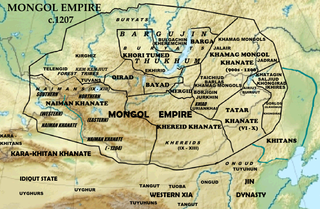Amir Chūpān, also spellt Choban or Coban, was a Chupanid noble of the Ilkhanate, and nominal general of the Mongol Empire. His father was named the Malek of the Mongol Suldus clan. His ancestor was Chilaun (Чулуун), who was one of Chingis Khan's four great companions.
Tughlugh Timur Khan (1329/30-1363) was the Khan of Moghulistan from c. 1347 and Khan of the whole Chagatai Khanate from c. 1360 until his death. Esen Buqa is believed to be his father. His reign is known for his conversion to Islam and his invasions of Transoxiana.
Qara Hülegü was head of the ulus of the Chagatai Khanate. He was the son of Mö'etüken, and a grandson of Chagatai Khan.

Bayan Qulï was khan of the Chagatai Khanate from 1348 to 1358 and a grandson of Duwa.
Khabul Shah was khan of the Chagatai Khanate from 1364 to 1370.
Duwa Temür (Дуватөмөр) or Tore Temur (Төртөмөр) was khan of the Chagatai Khanate for a period in 1329/1330. He was the son of Duwa.
Mengu-Timur or Möngke Temür (?–1280), son of Toqoqan Khan and Buka Ujin of Oirat and the grandson of Batu Khan. He was a khan of the Golden Horde, a division of the Mongol Empire in 1266–1280. His name literally means "Eternal Iron" in the Mongolian language.
Qazaghan was the amir of the Qara'unas and the effective ruler of the Chagatai ulus (1346–1358).
Abdullah was the leader of the Qara'unas (1358–1359) and the ruler of the Chagatai ulus (1358). He was the son of Amir Qazaghan.

Moghulistan, also called the Eastern Chagatai Khanate, was a Mongol breakaway khanate of the Chagatai Khanate and a historical geographic area north of the Tengri Tagh mountain range, on the border of Central Asia and East Asia. That area today includes parts of Kazakhstan, Kyrgyzstan, and northwest Xinjiang, China. A khanate nominally ruled over the area from the mid-14th century until the late 17th century, although it is debatable whether it was a continuation of the Chagatai Khanate, an independent khanate, or a tributary state to Ming Dynasty China.

The Tayichiud was one of the three core tribes of the Khamag Mongol confederation in Mongolia during the 12th century.
Bayan (r.1302-1309) was one of the most famous khans of White Horde. "Bayan" means "rich" and "buyan" means "good deed/act" in the Mongolian language.
The Qara'unas or Negüderi were a Mongol people that settled in Afghanistan after moving from Turkestan and Mongolia.

Timur, historically known as Amir Timur and Tamerlane, was a Turco-Mongol conqueror. As the founder of the Timurid Empire in Persia and Central Asia, he became the first ruler in the Timurid dynasty. According to John Joseph Saunders, Timur was "the product of an islamized and iranized society", and not steppe nomadic.

The battle of Balkh was a key success in Timur's rise to power, and established him as the ruler of the western Chaghatai in Transoxiana.
The Kaidu–Kublai war was a war between Kaidu, the leader of the House of Ögedei and the de facto khan of the Chagatai Khanate in Central Asia, and Kublai Khan, the founder of the Yuan dynasty in China and his successor Temür Khan that lasted a few decades from 1268 to 1301. It followed the Toluid Civil War (1260–1264) and resulted in the permanent division of the Mongol Empire. By the time of Kublai's death in 1294, the Mongol Empire had fractured into four separate khanates or empires: the Golden Horde khanate in the northwest, the Chagatai Khanate in the middle, the Ilkhanate in the southwest, and the Yuan dynasty in the east based in modern-day Beijing. Although Temür Khan later made peace with the three western khanates in 1304 after Kaidu's death, the four khanates continued their own separate development and fell at different times.






